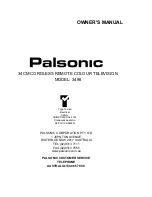
35
T
ips Befor
e
Connecting
T i p s t o R e a d B e f o r e C o n n e c t i n g C o m p o n e n t s
Compatible Components
A wide variety of compatible Video Cassette Recorders
(VCRs), camcorders, laserdisc players, and audio
components are available. Check with your dealer for
details.
Other brands of components can also be connected to your
TV. Refer to the component’s owner’s manual for the
manufacturer’s recommended hookup instructions.
Positioning Components on Shelves
To ensure the best performance from your components,
follow these general guidelines when arranging them on
the shelves of a component compartment.
Amplifiers, receivers, and VCRs generate heat during
operation, so special care should be taken when arranging
these components in the compartment. Do not stack an
amplifier (or receiver) and a VCR directly on top of each
other because each component generates heat and may not
provide the best performance if stacked together. Do not
stack other components directly on top of an amplifier,
receiver, or VCR.
If you include both an amplifier (or receiver) and a VCR,
put the amplifier on the top shelf and put the VCR on the
bottom shelf. Leave at least four inches of clearance above
the amplifier (or receiver) and at least two inches of
clearance above other components.
If you have just a VCR and no amplifier (or receiver),
position the VCR on the bottom shelf. Do not stack
anything else directly on top of the VCR. Leave at least
two inches of clearance between the VCR and the shelf
above it.
Some VCRs may cause interference in TV sets if they are
placed too close to the TV. The ProScan cabinets have a
built-in interference barrier to help eliminate this type of
interference. If you are using another type of cabinet and
interference is present when using your VCR, try placing
the VCR on the bottom shelf or try plugging the TV and
VCR power cords into different wall sockets.
Turn Off Power Before Connecting Components
Always turn off power to all components before you
connect or disconnect any cables. This will protect your
components from possible electrical surges that could
damage your equipment.
This is a good practice for all your audio and video
components – TVs, VCRs, audio systems, computers, etc.
Plugging in Power Cords
Do not plug any power cord into a wall outlet until you are
finished making connections.
Many components have “convenience outlets” on their
back panels so you can plug power cords from other
components into a “convenience outlet” instead of a wall
outlet. Usually these outlets will be labeled either
“switched” or “unswitched”.
If the outlet is labeled “switched”, that means power to the
outlet will be switched off when the component’s power
button is switched off.
If the outlet is labeled “unswitched”, that means power will
always be available at that outlet, even when the
component is turned off.
Depending on the size of your system, you may prefer to
use an extension cord or a “multiple adapter” to get enough
outlets for all your components.
The power cords on your ProScan components are
“polarized” (one blade is wider than the other). Be sure
the extension cord or multiple adapter is also polarized.
The plug should fit in the outlet only one way.
Position Cables to Avoid Hum
The possibility of picking up hum (interference noise) in
the audio/video cables will be reduced if you keep them
away from the back of the TV. Route the cables to the
sides of the TV’s back panel instead of straight down the
middle.
All cable plugs should be firmly seated in the jacks where
they connect to the equipment. If a plug is not connected
firmly, audio hum or smeared video may result.
If your antenna cable is flat twin-lead cable, try to keep it
away from the audio/video cables as much as possible.
Excess flat, twin-lead cable should be cut off instead of
coiled behind the TV. Round, coaxial, antenna cable is
usually shielded and can be coiled or placed next to
audio/video cables without causing interference.
Position Speakers to Avoid Interference
Placing external speakers with unshielded magnets too
close to the TV may result in the speaker magnets affecting
the quality of the picture. Such speakers should be located
at least eight inches away.
If unshielded speakers are too close to the TV, colored
streaks will appear along the sides of the picture. If this
happens, turn off the TV for several minutes while moving
the speakers farther away. Then turn the TV back on.
The ProScan SPK060 speakers are completely shielded
and can be positioned next to the TV without affecting the
picture.
















































